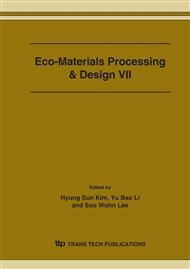p.286
p.290
p.294
p.298
p.302
p.306
p.310
p.314
p.318
Effect of Impurity and Gas Nature on Microstructure of SiC Microtubes in Double Step Reaction Process
Abstract:
A novel process in the synthesis of SiC microtubes is proposed, based on modified CVD process. This process was adopted to siliconize the carbon fibers that perform with relatively small surface area, either partially or completely, into the SiC microtubes with large surface area. An oxidic vapor generated from a metal reacts with a carbon solid preform, which leads to a carbide possessing with a unique morphology. The carbon fiber preforms have been unidirectionally arranged into alumina tube, and then a solid-vapor reaction between carbon fiber preforms and SiO vapor originated from the mixture powder pack of Si and SiO2 has been carried out in restoration atmosphere (argon gas/hydrogen gas = 80/20) at 1450°C. The synthesized SiC.C composites were re-sintered with the modified mixture powder pack of Si, SiO2, Al, and Al2O3 at the same condition, in which amounts of Al and Al2O3 employed as a impurity have been controlled under 1 wt% with different mole ratios (Al2O3 : Al = 1:1, 2:1, 3:1). Two kinds of SiO and AlO vapors are generated in the second step reaction process, which react with carbon residuals. The quantitative and qualitative properties of the SiC micorotubes were analyzed by using TGA, SEM, and XRD. The inner morphology of the SiC micorotubes is dependent on the impurity concentration and the gas nature, showing the grains grown with membrane type in the second reaction process because of the impurity.
Info:
Periodical:
Pages:
302-305
Citation:
Online since:
March 2006
Keywords:
Price:
Сopyright:
© 2006 Trans Tech Publications Ltd. All Rights Reserved
Share:
Citation:


